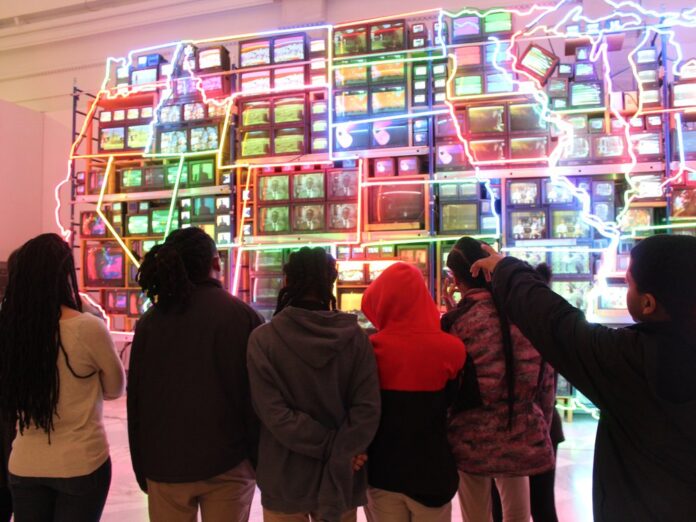Museum educators at the National Museum of Asian Art and the Smithsonian American Art Museum have developed programs to equip teachers and students alike with strategies to slow down. This programming has guided participants in appreciating art, checking-in with themselves, and developing empathy.
The last two years have been extremely taxing on the well-being of classroom educators and their learners. Teachers are feeling burnt out, underappreciated, and are leaving the field in record numbers. According to a RAND June 2021 survey, teachers were almost three times more likely to report symptoms of depression than other adults. Over the past two years, teachers have been reporting that students are regressing in emotional intelligence (the ability to recognize, understand, and manage one’s own emotions) and are having difficulty regulating their emotions and maintaining classroom normative behaviors. These observations are substantiated by the U.S. Surgeon General’s December 2021 warning of a “devastating” mental health crisis for teens.
What is social-emotional learning? The Collaborative for Academic, Social, and Emotional Learning (CASEL) defines social-emotional learning as “the process through which all young people and adults acquire and apply the knowledge, skills, and attitudes to develop healthy identities, manage emotions and achieve personal and collective goals, feel and show empathy for others, establish and maintain supportive relationships, and make responsible and caring decisions.” Dale-Deines and Reifsteck looked to the CASEL framework to develop their resources with their partners.
Slowing Down
In October 2020, the National Museum of Asian Art, in partnership with mindfulness education non-profit Create Calm, launched the Artful Movement virtual field trip program for PreK-6th grade audiences. Artful Movement combines breathing practices, slow looking at art, and movement inspired by the work of art. In terms of Social and Emotional skills development, students recognize their emotions, learn stress management techniques, and develop their cultural competencies by participating in the virtual field trip. Since its inception, over 800 students and educators have participated in the Artful Movement virtual field trip.
Create Calm and National Museum of Asian Art educators selected Hokusai’s Thunder god as the focus object for Artful Movement. The background of the hanging scroll depicts a large, swirling cloud set against a black sky with red laser beams of lightning shooting from the corner of the painting. Floating in front of the ominous sky is the Thunder god who seems as dynamic and energized as the background.

Many students see the red, bumpy skin and the spiky grin of Hokusai’s Thunder god and label the being as a demon. After students share their perspectives, they learn from the educator the title of the painting and that red in Japanese art is a symbol of power and vitality. Then, they metaphorically move their bodies from a rain drop to a cloud, then to wind, rain, crashing lightning and booming thunder. After the storm, they settle into a puddle, with an invitation to ponder the nourishment they provided to the earth. With this new knowledge, they perhaps begin to see the Thunder god as a benevolent, helpful being.
“Slow looking allows one to see beyond what can be noticed at first glance. Through closer inspection and more information, you may experience a perspective shift. Slow looking at art is a powerful, transferable skill that allows one to uncover biases and prejudices,” says Reifsteck.
As you look up from your computer and connect with your students, coworkers, or family members, look for opportunities to check in with yourself. How are you feeling? What seems strange to you in the world? What might you gain from maintaining a stance of curiosity?
Reflective Analysis
Art can be an effective tool for fostering social-emotional awareness in students and adults alike. It has the potential to help us understand ourselves, our peers, and our environment more deeply. Designing for society can be challenging as it requires considering various factors such as sociology, psychology, economics, and politics, specifically the topics that I explore in my articles. Emotional awareness of society is an important component that has to be considered when designing for society, as it helps to create products and services that are tailored to the needs and emotions of the people. This understanding of social awareness and emotional design will aid me in my research on human-centered design.
Source
Magazine, S. (2022, July 5). How art can foster social-emotional awareness for our students (and ourselves). Smithsonian.com. https://www.smithsonianmag.com/blogs/smithsonian-education/2022/07/05/how-art-can-foster-social-emotional-awareness-for-our-students-and-ourselves/




